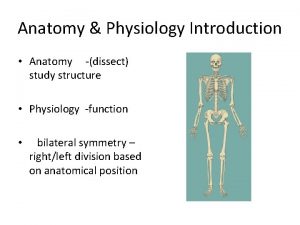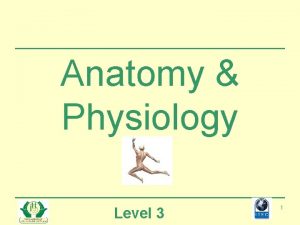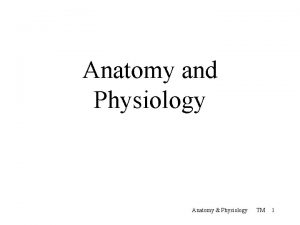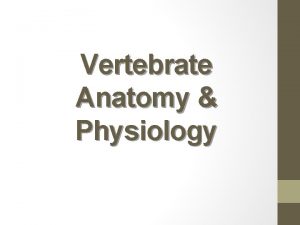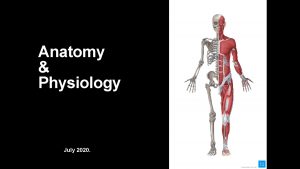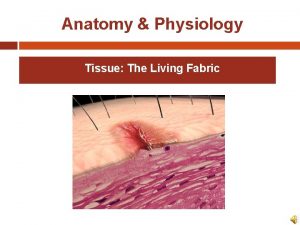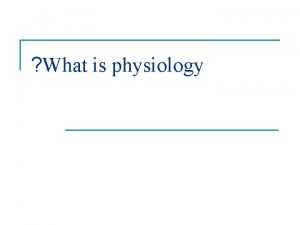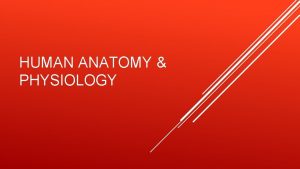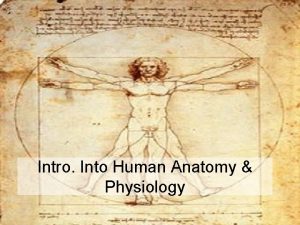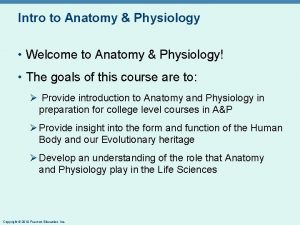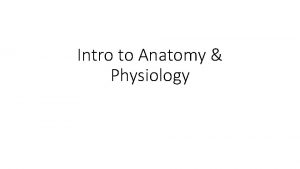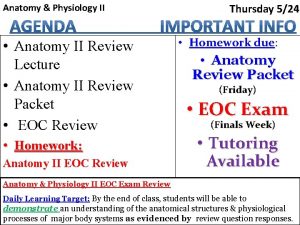Anatomy and Physiology An Introduction Anatomy and Physiology


































- Slides: 34

Anatomy and Physiology An Introduction

Anatomy and Physiology (A&P) n Anatomy – branch of science that deals with the structure (morphology) of body parts ¨ Forms and organization n Physiology – functions of the body parts n All the parts together with their functions make up the human organism

Characteristics of Life n n n Movement Responsiveness Growth Reproduction Respiration n n Digestion Absorption Circulation Assimilation Excretion Definitions on page 4 -5 of book. Metabolism – chemical changes considered together within the body

Requirements of Organisms n Water – required for many metabolic processes ¨ Regulates body temp ¨ Transports substances n Foods – provide body with necessary chemicals (nutrients) ¨ Some chemicals used as energy ¨ Others are materials for building structures

Requirements of Organisms n Oxygen – gas used to release energy from food substances ¨ Energy n released drives metabolic processes Heat – form of energy that is a product of metabolic reactions ¨ Temperature n is a measurement of the amount of heat Pressure – application of force to something ¨ Atmospheric pressure – force on the outside of the body ¨ Hydrostatic pressure – force exerted by a liquid

Homeostasis n Homeostasis – state of balance in which the body’s internal environment stays within the normal range ¨ Concentrations of water, nutrients, oxygen and conditions of heat and pressure must be maintained ¨ Brought back into range by homeostatic mechanisms ¨ Discussion: Thermostat

Homeostasis cont. ¨ Discussion: ¨ Set Your body’s “thermostat” point: 37 degrees C (98. 6 deg. F) ¨ Fig. 1. 6/1. 7

Body’s Thermostat Human Response to Overheating Human Response to becoming Too Cold Metabolism is reduced. As a result less heat is produced. Metabolism is increased. As a result more heat is produced. Sweating: evaporation has a cooling effect as it takes heat from the body Shivering: muscles contract to produce more heat Blood vessels in the skin dilate. This allows blood to constrict. This keeps blood bring more heat to the surface. and warmth deep in the tissues so that heat isn’t lost through the skin.

Homeostasis cont. n Self regulating mechanisms use “feedback” about changes from set point ¨ Negative feedback mechanisms common in body n Normal “Range"

Levels of Organization Atom Molecule Macromolecule n Organelles – found within cells n Cells – basic unit of structure and function n ¨ Many n different types of cells Tissues – organized layers of cells that have a common function ¨ Epithelial, connective, muscular, nervous

Levels of Organization n Organs – complex groups of tissues with specialized functions ¨ Examples n include stomach, liver, heart Organ Systems – groups of organs that function together ¨ Examples include digestive and circulatory systems

Organization – Body Cavities n Two major portions: ¨ Axial portion – head, neck, trunk ¨ Appendicular portion – upper and lower limbs n Figure 1. 8 Major body cavities n Organs contained within a body cavity are known as visceral organs or viscera

Axial Body Cavities n Dorsal cavity ¨ Cranial cavity – contains brain ¨ Vertebral canal – contains spinal cord within sections of the backbone (vertebrae)

Lab Safety Quiz 1. 2. 3. 4. 5. Where is the first aid kit? When must safety goggles be worn? Where is the safety shower? Where is the fire alarm pull? What is Ms. Reynolds favorite color?

Axial Cavities cont. n Ventral cavity ¨ Thoracic cavity n Mediastinum – heart, esophagus, trachea n Pleural cavity – lungs ¨ Thoracic and abdominopelvic cavities separated by diaphragm

Axial Cavities cont. n Ventral Cavity cont. ¨ Abdominopelvic cavity n Abdominal cavity – small/large intestines, stomach, liver, pancreas, spleen, gall bladder, kidneys n Pelvic cavity – terminal portion of large intestines, urinary bladder, internal reproductive organs ¨ Enclosed by hip bones


Head Cavities Oral cavity – teeth and tongue n Nasal cavity – located within nose n Orbital cavities – eyes and associated muscles and nerves n Middle ear cavities – middle ear bones n Fig. 1. 9

Membranes n There are 2 layers of membranes around organs in body cavities ¨ Parietal – membrane attached to wall of cavity ¨ Visceral – deeper membrane that covers internal organ n Walls of thoracic compartments lined with parietal pleura while lungs are covered by visceral pleura n Pleural membranes separated by serous fluid (thin, watery, fluid film)

Membranes cont. Pericardium – heart n Peritoneum – organs of the abdominopelvic cavity n

Human Organ Systems n Skeletal n n Muscular n n Circulatory n n Immune n n Respiratory n n Digestive Excretory Reproductive Nervous Endocrine Integumentary

Human Skeletal System n. Functions ¨Framework and support ¨Protection ¨Storage n. Axial and appendicular skeleton n. Bone structure n. Joints and ligaments

Human Muscular System n Functions ¨ Movement ¨ Warmth ¨ Posture n Muscle Properties ¨ Ability to contract ¨ Ability to be stretched ¨ Ability to respond to a stimulus

Human Nervous System n. Controls and coordinates functions throughout the body n. Neurons are specialized cells that transmit impulses throughout the body.

Human Endocrine System n. The endocrine system consists of ductless glands that produce hormones. ¨Hypothalamus, pituitary, pineal, thyroid, parathyroid, thymus, adrenal, pancreas, ovary, testes n. Hormones are chemical messengers that travel through the blood stream and affect activities throughout the body.

Human Circulatory System n. Transports nutrients, gases, wastes, water, and hormones and also distributes heat n. Structures of circulatory system ¨Heart ¨Vessels ¨Blood n. Lymphatic Erythrocytes system White blood cells

Human Digestive System n. Digestion is the breakdown of nutrients to a level that can be used by cells of the body. n. Structures ¨GI tract (mouth, pharynx, esophagus, stomach, small intestine, large intestine) ¨Accessory (teeth, tongue, salivary glands, liver, gall bladder, pancreas) n. Nutrition

Human Respiratory System n. Respiration is gas exchange between an organism and the environment ¨Oxygen enters blood and carbon dioxide leaves blood in lungs n. Respiratory structures include the nose, pharynx, larynx, trachea, bronchioles and alveoli

Human Excretory/Urinary System n. Excretion is the removal of metabolic wastes from the body, including toxic chemicals, excess water, carbon dioxide and salts. n. Excretory Organs ¨Skin ¨Lungs ¨Kidneys ¨Bladder

Human Reproductive System n. Produces gametes (eggs and sperm) n. Fertilization – produce zygote n. Male Reproductive System ¨Testes, scrotum, penis ¨Epididymus, vas deferens, urethra, seminal vesicle, prostate gland n. Female Reproductive System ¨Ovaries ¨Fallopian tubes, uterus, vagina

Anatomical Terminology n Relative Positions ¨ Superior/inferior – towards ceiling/floor ¨ Anterior/posterior – forward/backward ¨ Ventral/dorsal – towards bellybutton/back ¨ Medial/lateral – middle/to either side ¨ Proximal/distal – closer to body/farther from body (ONLY LIMBS!!!) ¨ Superficial/deep – surface/below the surface ¨ Peripheral – out from the middle to sides

Anatomical Terminology


 Chapter 1 introduction to human anatomy and physiology
Chapter 1 introduction to human anatomy and physiology Distal and proximal
Distal and proximal Cephalic cranial
Cephalic cranial Physiology of respiration
Physiology of respiration Tattoo anatomy and physiology
Tattoo anatomy and physiology Anatomy science olympiad
Anatomy science olympiad Crown plants examples
Crown plants examples Anatomy and physiology of bone
Anatomy and physiology of bone Anatomy and physiology of peptic ulcer ppt
Anatomy and physiology of peptic ulcer ppt Liver anatomy
Liver anatomy Difference between anatomy and physiology
Difference between anatomy and physiology Hypogastric region
Hypogastric region Google com
Google com The central sulcus divides which two lobes? (figure 14-13)
The central sulcus divides which two lobes? (figure 14-13) 3 layers of muscle
3 layers of muscle Http://anatomy and physiology
Http://anatomy and physiology Physiology of appendix
Physiology of appendix Aohs foundations of anatomy and physiology 1
Aohs foundations of anatomy and physiology 1 Aohs foundations of anatomy and physiology 2
Aohs foundations of anatomy and physiology 2 Anatomy and physiology of swine
Anatomy and physiology of swine Anatomy and physiology chapter 8 special senses
Anatomy and physiology chapter 8 special senses Chapter 13 anatomy and physiology of pregnancy
Chapter 13 anatomy and physiology of pregnancy Teks anatomy and physiology
Teks anatomy and physiology Science olympiad anatomy and physiology 2020 cheat sheet
Science olympiad anatomy and physiology 2020 cheat sheet Chapter 2 basic chemistry anatomy and physiology
Chapter 2 basic chemistry anatomy and physiology Physiology of stomach ppt
Physiology of stomach ppt Anatomy and physiology of diabetes
Anatomy and physiology of diabetes Chapter 7 anatomy and physiology
Chapter 7 anatomy and physiology Anatomy and physiology coloring workbook figure 14-1
Anatomy and physiology coloring workbook figure 14-1 Chapter 10 blood anatomy and physiology
Chapter 10 blood anatomy and physiology Aohs foundations of anatomy and physiology 1
Aohs foundations of anatomy and physiology 1 Aohs foundations of anatomy and physiology 1
Aohs foundations of anatomy and physiology 1 Anatomy and physiology
Anatomy and physiology Anatomy and physiology chapter 15
Anatomy and physiology chapter 15 Cornell notes for anatomy and physiology
Cornell notes for anatomy and physiology





































